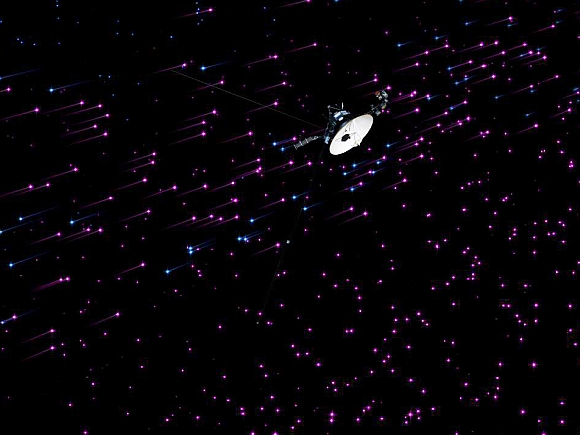Photographs: Courtesy: NASA/JPL-Caltech
NASA's Voyager 1 has entered a new and unexpected region at the far reaches of our solar system that scientists believe is the final area the spacecraft has to cross before reaching interstellar space.
Voyager 1 and its sister probe Voyager 2 have been travelling through space since 1977, and are close to becoming the first manmade objects to leave the solar system.
Voyager 1 has entered a new region of the heliosphere that scientists are calling a 'magnetic highway', which allows charged particles from inside the heliosphere to flow outward, and particles from the galaxy outside to come in, Space.com reported.
Scientists believe this region is still inside our solar bubble because the direction of the magnetic field lines has not changed. The direction of these magnetic field lines is predicted to change when Voyager breaks through to interstellar space.
...
NASA's Voyager 1 spacecraft enters 'magnetic highway'
Image: This still image show NASA's Voyager 1 spacecraft exploring a new region in our solar system called the magnetic highwayPhotographs: Courtesy: NASA/JPL-Caltech
So far, this field still runs east-west, in agreement with the field created by the sun and twisted by its rotation. Outside the solar system, models predict the magnetic field to be orientated more north-south.
"Although Voyager 1 still is inside the sun's environment, we now can taste what it's like on the outside because the particles are zipping in and out on this magnetic highway," Edward Stone, Voyager project scientist based at the California Institute of Technology, Pasadena said in a statement.
"We believe this is the last leg of our journey to interstellar space. Our best guess is it's likely just a few months to a couple years away. The new region isn't what we expected, but we've come to expect the unexpected from Voyager," Stone said.
As Voyager 1, the outermost of the two spacecraft, gets farther and farther away, it measures more and more of the higher-energy charged particles thought to originate beyond the solar system, compared to the lower-energy particles thought to come from the sun.
...
NASA's Voyager 1 spacecraft enters 'magnetic highway'
Image: This artist's concept shows how NASA's Voyager 1 spacecraft is bathed in solar wind from the southern hemisphere flowing northwardPhotographs: Courtesy: NASA/JPL-Caltech
"Things have actually changed dramatically. The particles from outside have increased a lot and those on the inside have dropped quite a bit," said Stamatios Krimigis, principal investigator of the low-energy charged particle instrument, based at the Johns Hopkins Applied Physics Laboratory.
The Voyagers will keep traveling outward even after they've left the sun's neighbourhood. However, it will be at least 40,000 years before they ever come close to another star, Stone said.
Long before that the probes will run out of power to operate their scientific instruments and beam their findings back home. "We will have enough power for all the instruments until 2020; at that point we will have to turn off our first instrument," Stone said.
Voyager 1 will also have to be turned off by 2025. The new results were described at the American Geophysical Union meeting in San Francisco on Monday.




article